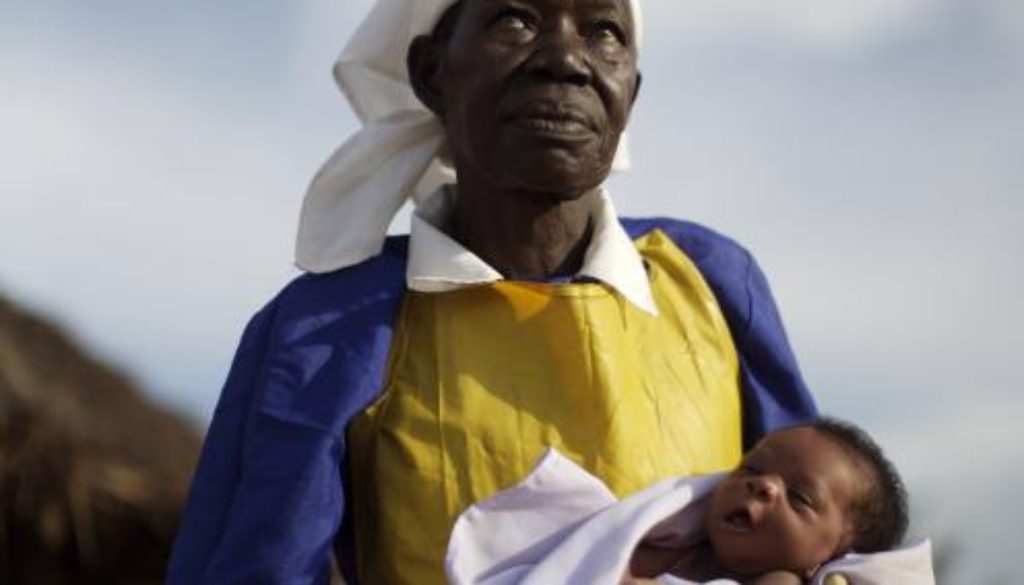Winning photo announced
The aim of this competition was to capture the everyday stories of how gender plays out within health systems around the world. Through these visual stories we hope to inspire imagination and provoke assumptions about what gender means for the health systems we engage with. Capturing nuances or startling us; images communicate powerfully and symbolically; in ways that are sometimes more enticing, convincing and memorable, than the tomes of written evidence that may or may not be read or remembered. The photo was taken by Amref Health Africa.
Asha George
The winning photo resounds with the strength, dignity and confidence of a woman proud of her contributions despite the challenges faced. She shines like a ray of hope parting the stormy clouds of circumstance in Uganda. While the child almost yawns in the comfort of her cradle, she is unlike other madonnas. We look up to her and she is wearing the gloves and a uniform of a female vocation and profession that is under negotiation and transformation. The photo presents a strong, positive image, taking a conventional role and presenting it in an unconventional and affirming manner. It was scored unanimously by the judges as the winning photo.
Other photos were listed for honourable mentions for highlighting women actively on the frontlines of service delivery, whether registering other women and children in Indonesia, weighing them in Uganda or immunizing them in Ethiopia. They did so with vigour and humour as shown by the TBAs in Guinea Bissau. Although many photos featured women working in communities as volunteers or community health workers, there were fewer photos of them as facility based health professionals. While many of the photos highlighted women serving other women primarily through community or preventive services, very few highlighted possible gendered training or working conditions of these frontline health workers. Furthermore, only one photographer documented a woman in a managerial role: a nursing officer in Uganda resting on her motorcycle, self-assured while straddling a vehicle typically associated with men. One photo not selected for honourable mention showed an immunization officer and health committee member who were nursing mothers themselves. These images remind us of the varied roles that women play in health systems.
Men were also highlighted in gender transformative ways by the photo competition. Men in a group listened and discussed spousal communication and family planning in India, while another photo captured a young man studying obstetric nursing in Ghana. While these were good examples, there were not many submissions documenting the role of men in engaging in gender issues as a way of transforming health systems.
Other photos listed for honourable mention highlighted collaborative efforts linking women and men in changing health systems. In Cambodia, a hospital offering training for both male and female nurses emphasized positive images within facility based care. A student activist campaign within a public health training institution in the USA challenged them to think about gender norms in their personal and professional lives.
Photos were selected for demonstrating diverse contexts, whether ranging from HIV testing and peer education among nomadic populations in rural Kenya or home visits by community health workers supporting adolescent mothers in Indian urban slums. Only one photographer submitted photos within a hospital ward setting and very few photo submissions were about the training institutions that support health systems. Women of different generations in Bolivia, sitting in front of gender based violence health education material, remind us of the variety of needs women have even within the same context. Photos were selected from all regions of the world, representing different types of populations and settings.
The competition elicited a range of photographers, from professional photographers, project managers, donors, researchers, activists and lay community members. Two of the submissions winning honourable mention were photovoice entries, where community members themselves get behind the photographic lens to document and narrate their stories. One highlighted the role of women in street performance peer education activities for maternal health in Uganda and another profiled a woman from a marginalised community learning how to use a camera to document community resilience in an ecologically vulnerable region in India.
The question of who has the right to take and display images, under what contexts and for what purpose permeated the photo competition. Although, we disseminated guidelines on the ethics of informed consent for photography, only one photographer made reference to a code of conduct with regards to use of images. Most photographers reported verbal consent or written consent where possible. One reason why written consent was not possible in some instances was because of a plethora of local languages. Nonetheless, several photo submissions did not detail consent, or reported consent that was more casual in manner: people seeking consent by pointing at the camera and seeking consent non-verbally. There is a difference between seeking consent for taking a photo, whether for personal memories or for professional imperatives, and seeking consent for disseminating the image publically, whether for profit or non-profit motives.
Ethical principles in photography and use of images, go much beyond issues of consent. They span issues of justice, autonomy, non-maleficence, beneficence and fidelity. Are we representing subjects respectfully, in ways that do not further marginalise, stigmatise or exploit them personally, but that raises questions about their health system realities and broader public health priorities to support constructive social change?
Who benefits from the dissemination of images? As researchers, we were surprised by the number of photographers who objected to our photo competition, because it did not offer a financial reward of some kind. We offered dissemination of the photos with due credits at the Cape Town Health Systems Global Symposium and through other means where possible. It was heartening to learn about the struggles faced by professional photographers, yet I am not certain that affirming exclusive royalty agreements necessarily serve the broader public good, anymore than they do for research.
Photos are even more personal than research findings, because they can be more irrefutably identifiable or contextually revealing. It is striking to me that photo credits are usually for the photographer alone, and don’t always acknowledge the photographee or organisation sponsoring the photographer. Feminist research ethics interrogates who has the right to be an author representing the realities of others. How do we apply such principles to photography?
Several photos that were not selected for honourable mention but that were still striking were those that chronicled women’s hard, back-breaking labour: whether carrying heavy loads, undertaking agricultural work, fishing or crab collecting, at times when pregnant. In direct contrast, several submissions also portrayed women passively, often as motionless mothers and children, despite the terms of the photo competition. And finally, there were a few photos, which we were not clear what they were meant to be about. Such is the fate of opening a call for anyone to participate!
We thank everyone for participating, those who gave consent for their photos to be taken and disseminated, and those with cameras for their interest in submitting photos, despite not having monetary prizes, and look forward to profiling the photos with credits at the Cape Town health systems symposium. Hope the images spur further interest, conversation and engagement in transforming health systems for the better!
To find our more about RinGs visit our webpage.

